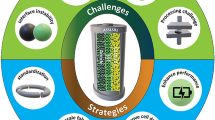Abstract
With the expanding applications, concerns about the charging safety of lithium-ion batteries (LIBs) have become more significant. In this paper, the constant-current (CC) overcharge electrode process of pouch LiCoO2/graphite batteries are analyzed at 0.25 C, and then, a self-protection mechanism for decreasing the overcharge risk of batteries is evaluated. As for the batteries passing the safety test, their typical overcharge behaviors show the battery voltage and temperature begin to dramatically increase to about 5.2 V and 65 °C from about 155% state of charge (SOC) and then decrease slowly after a short fluctuating period. The element analysis of two electrodes and separator reveals that besides the well-known metal lithium, cobalt precipitation pierces the separator and subsequently forms an internal micro-short circuit at about 155% SOC to consume the charge energy and subsequently avoid the overcharge explosion and ignition. As a conclusion, a self-protection mechanism based on an internal micro-short circuit model, which is closely related with the deposited electric lithium and cobalt and the separator porosity, is proposed and experimentally verified. These results offer an idea and method to decrease the CC overcharge risk of LIBs and can advance the safe application of LIBs.








Similar content being viewed by others
References
Zhu J, Wierzbicki T, Li W (2018) A review of safety-focused mechanical modeling of commercial lithium-ion batteries. J Power Sources 378:153–168
Noelle DJ, Wang M, Le AV, Shi Y, Qiao Y (2018) Internal resistance and polarization dynamics of lithium-ion batteries upon internal shorting. Appl Energy 212:796–808
Ruiz V, Pfrang A, Kriston A, Omar N, Bossche den PV, Boon-Brett L (2018) A review of international abuse testing standards and regulations for lithium ion batteries in electric and hybrid electric vehicles. Renew Sust Energ Rev 81:1427–1452
Larouche F, Demopoulos GP, Amouzegar K, Bouchard P, Zaghib K (2018) Recycling of Li-ion and Li-solid state batteries: the role of hydrometallurgy. Extraction 2541–2553
Biensan P, Simon B, Peres JP, Guibert A, Broussely M, Bodet JM, Perton F (1999) On safety of lithium-ion cells. J Power Sources 81:906–912
Tobishima S, Yamaki J (1999) A consideration of lithium cell safety. J Power Sources 81:882–886
Saito Y, Takano K, Negishi A (2001) Thermal behaviors of lithium-ion cells during overcharge. J Power Sources 97-8:693–696
Wen J, Yu Y, Chen C (2012) A review on lithium-ion batteries safety issues: existing problems and possible solutions. Mater Express 2(3):197–212
Spotnitz R, Franklin J (2003) Abuse behavior of high-power lithium-ion cells. J Power Sources 113(1):81–100
Leising RA, Palazzo MJ, Takeuchi ES, Takeuchi KJ (2001) A study of the overcharge reaction of lithium-ion batteries. J Power Sources 97-98:681–683
Ouyang MG, Ren DS, Lu LG, Li JQ, Feng XN, Han XB, Liu GM (2015) Overcharge-induced capacity fading analysis for large format lithium-ion batteries with LiyNi1/3Co1/3Mn1/3O2 + LiyMn2O4 composite cathode. J Power Sources 279:626–635
Ohsaki T, Kishi T, Kuboki T, Takami N, Shimura N, Sato Y, Sekino M, Satoh A (2005) Overcharge reaction of lithium-ion batteries. J Power Sources 146(1-2):97–100
Yuan QF, Zhao FG, Wang WD, Zhao YM, Liang ZY, Yan DL (2015) Overcharge failure investigation of lithium-ion batteries. Electrochim Acta 178:682–688
Ecker M, Sabet PS, Sauer DU (2017) Influence of operational condition on lithium plating for commercial lithium-ion batteries: electrochemical experiments and post-mortem analysis. Appl Energy 206:934–946
Perea A, Paolella A, Dubé J, Champagne D, Mauger A, Zaghib K (2018) State of charge influence on thermal reactions and abuse tests in commercial lithium-ion cells. J Power Sources 399:392–397
Sharma N, Peterson V (2013) Overcharging a lithium-ion battery: effect on the LixC6 negative electrode determined by in situ neutron diffraction. J Power Sources 244:695–701
Sun F, Moronic R, Dong K, Markotter H, Zhou D, Hilger A, Zielke L, Zengerle R, Thiele S, Bahart J, Manke I (2017) Study of the mechanism of internal short circuit in a Li/Li cell by synchrotron X-ray phase contrast tomography. ACS Energy Lett 2(1):94–104
Zhang K, Ren F, Wang XL, Mehta A, Yu XQ, Liu YJ (2017) Finding a needle in the haystack: identification of functionally important minority phases in an operating battery. Nano Lett 17(12):7782–7788
Huang PF, Verm A, Robles DJ, Wang QS, Mukherjee P, Sun JH (2018) Probing the cooling effectiveness of phase change materials on lithium-ion battery thermal response under overcharge condition. Appl Therm Eng 132:521–530
Xiao L, Ai XP, Cao YL, Yang HX (2004) Electrochemical behavior of biphenyl as polymerizable additive for overcharge protection of lithium ion batteries. Electrochim Acta 49(24):4189–4196
Lee H, Lee JH, Ahn S, Kim HK, Cho JJ (2006) Co-use of cyclohexyl benzene and biphenyl for overcharge protection of lithium-ion batteries. Electrochem Solid-State Lett 9(6):A307–A310
Feng XM, Ai XP, Yang HX (2004) Possible use of methylbenzenes as electrolyte additives for improving the overcharge tolerances of Li-ion batteries. J Appl Electrochem 34(12):1199–1203
Huang DH, Liu R, Fan WZ, Yu L (2017) 2,4-difluorobiphenyls as overcharge protection additive of high-voltage Li-ion battery. Chin Batt Mon 47:223–225
Zhao MK, Zuo XX, Ma XD, Xiao X, Yu L, Nan JM (2016) Diphenyl disulfide as a new bifunctional film-forming additive for high-voltage LiCoO2/graphite battery charged to 4.4 V. J Power Sources 323:29–36
Ma Y, Wang LS, Zuo XX, Nan JM (2018) Co-precipitation spray-drying synthesis and electrochemical performance of stabilized LiNi0.5Mn1.5O4 cathode materials. J Solid State Electrochem 22:1963–1969
Deng YM, Ma Z, Song XN, Cai ZD, Pang PP, Wang Z, Zeng RH, Shu D, Nan JM (2018) From the charge conditions and internal short-circuit strategy to analyze and improve the overcharge safety of LiCoO2/graphite batteries. Electrochim Acta 282:295–303
Funding
This work was financially supported by the science and technology projects of Guangzhou (201604016131) and the science and technology projects of Dongguan (201521511902).
Author information
Authors and Affiliations
Corresponding author
Rights and permissions
About this article
Cite this article
Deng, Y., Kang, T., Song, X. et al. Analysis on the constant-current overcharge electrode process and self-protection mechanism of LiCoO2/graphite batteries. J Solid State Electrochem 23, 407–417 (2019). https://doi.org/10.1007/s10008-018-4142-5
Received:
Revised:
Accepted:
Published:
Issue Date:
DOI: https://doi.org/10.1007/s10008-018-4142-5




